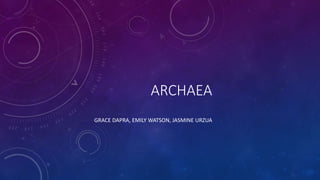
Period 6 2016
- 1. ARCHAEA GRACE DAPRA, EMILY WATSON, JASMINE URZUA
- 2. DEFINING CHARACTERISTICS • Archaea only survive in oxygen free environments. • Archaea was once consider a bacteria • Cell wall • Their are tree types of archaea • Generally 1-5 micrometers • Chromosomes are circular • No nucleus
- 3. CELL Cell type • The cell is a Prokaryote, it doesn't have a nucleus Cell surrounding • It contains molecules in their plasma membranes Cell organization • Unicellular • It's a single celled organism.
- 4. WHERE IT LIVES, AND HOW IT EATS • It can live in hot springs • Salty waters • And black mud • Oxygen free environments • It reproduces by binary fusion • It gets nutrients by it transfers food molecules into them self by protein pumps. • It's heterotroph and autotroph
- 5. EXAMPLES OF ORGANISMS AND IMPORTANCE Methanogers, halophiles, their mophiles, psychrophiles. They are important to us because scientist believed that archolebactena were the first life forms on earth billion of years!
- 6. Bacteria Sam Caflisch, Jacob Booker Per. 6
- 7. • Where it can live: Bacteria can live in your body, inside organisms, and on your skin. Characteristics: bacteria, shapes, rod, spiral, and sphere. How bacteria reproduces: bacteria reproduces by fusion.
- 8. • Bacteria gets its nutrients by heterotrophs.
- 9. • Bacteria is Prokaryote. The cell surrounding is a membrane
- 10. Protista Joshua Balcom Ella Runde
- 11. Domain Difining characteristics Eukaryotic cell It's a one celled thing that makes its own food
- 12. Lives, reproduction, nutrients Lakes, rivers, oceans, ponds, and Wet sediments It reproduces asexually Autotroph
- 13. Definition of Protista Any of numerous eukaryotic organisms that are not fungi, plants, or animals and are cheifly unicellular or colonial.
- 14. This organism has algae that helps feed fish It has a cell surrounding membrane Algae, paratmecium, and slime mold are examples of organisms The algae helps the fish have food
- 15. Kingdom Project: Fungi Made By: Garrett Lathan and Peyton Kirby Period 6
- 16. Characteristics,Where it can live and how it reproduces Some examples of characteristics are Sac fungi, Zygote fungi, Club fungi, Imperfect fungi, and Decomposers How it REPRODUCES Fungi can reproduce asexually and sexually
- 17. How it gets nutrients and Cell type • Some ways that Fungi can get nutrients are dissolving their food since they are heterotrophs • The cell that fungi have is eukaryote
- 18. Cellular organization and cell surrounding •They are Multicellular organisms •It's cell surrounding has a cell wall
- 19. Examples of Organisms and Importance to us • Some examples of organisms are Rigidoporous ulmarius, Sarcoscypha coccinea, Saccharomyees cerevisiae, Rhizopus stoloninfer, Anamita rubeseens • The importance to us is some types of fungi are used in foods, such as bread, meat, cheese, chocolate, sodas.They are used because of the protein and low cholesterol in them
- 20. Plantae BY: JONATHAN ANZUREZ , LUKA PERISIC ,REX KLEPFER
- 21. Domain, Defining Characteristics, Where it can live. Domain- Plantae's domain is Kingdom. . Defining Characteristics- Some characteristics are: They are producers. Over 250,000 different species They have a nucleus. They are the second largest kingdom Plantae is fed on by almost all living organisms. Without Plantae there would be no life on earth. Where it can live- They can live just about anywhere including Desert Woodland Rain Forest Swamps Ect;
- 22. Reproduction , Nutrients , Cell Type. Reproduction- Seedless plants reproduce when spores are carried through air or water into other seedless plants Seeded plants drop seeds and the seeds grow into other plants They are both asexual and sexual Nutrients- Plantae are Autotrophs, or the make their own food Cell Type- Plantae areProkaryotic because plants have different structures
- 23. Cell Surrounding , Cellular Organization , Organisms , Importance. Cell Surrounding-Cell Wall and Cell Membrane Cellular Organization-Multicellular Organisms-Trees. Ferns. Potatoes. Bananas. Moss. Importance-Supply oxygen, and are a food source. Major part of ecosystems.
- 24. Animalia By: Raina Donoho & De'Aisha Simmons Period- 6 Mrs. Kuhar
- 25. Domain, Defining Characteristics, & Cell Surrounding Domain- Eukaryote Defining Characteristics- Multicellular: which means that they are made up more than one cell. Some members of other kingdoms are just made up of one cell, like bacteria or amoeba. Animals digest their food. Animals have a protein called collagen, that surrounds the cells and helps them keep their shape. Animal cells are specialized for different functions, such as digestion, reproduction, vision, or taste. Cell Surrounding- An animal's cell has membranes, but an animal doesn't have a cell wall
- 26. Heterotroph & Eukaryote & multicellualr Heterotroph-animals get food from other animals or plants. Eukaryotes- animals are eukaryotes.-An organism consisting a cell or multiple cells Multicellular- animals are multicellular.
- 27. Animal Reproduction,Organisms,& important to us Animal Reproduction- Most animals reproduce sexually and some reproduce asexually also Organisms- monkeys🐒, horses🐴 alligators, tigers, pigs🐷 Animals are important to us because they get energy for life by eating other organisms So we can eat them.
- 28. Cellular Organization & Where It Can Live Cellular Organization- Animals are multicellular and have eukaryotes Where It Can Live- An animal can live just about anywhere, except inside volcanoes or something like that